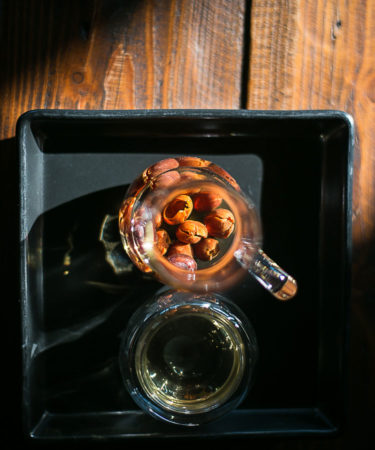There’s a lot to love about cascara, a coffee-tea hybrid made by steeping the dried husks of coffee fruit in water. It’s reasonably caffeinated, can be served hot or cold, and is the coffee industry’s answer to nose-to-tail eating.
In the past, cascara was a pulp many processors removed from around the coffee beans and promptly discarded. Now, enterprising producers are reserving these scraps, drying them, and packaging them as a tea. Baristas infuse them in hot tisanes, or make refreshing iced cascara drinks.
The term “cascara” is used interchangeably for both the fruit byproduct and beverages made from it. While relatively new to menus in the U.S. — Starbucks debuted a seasonal latte made with cascara-spiked simple syrup in 2017 — cascara has long been a part of beverage traditions in Bolivia, Ethiopia, and Yemen.
The process of separating cascara from the coffee beans is relatively straightforward, Sumi Ali, co-founder and roaster of Yes Plz Coffee, says. “After the coffee fruits are picked from the plant, they are fed through an aquapulper or depulper, a machine that strips and separates the skin and flesh of the fruit from the seed,” he says. “Seeds are processed and dried to become raw coffee beans. … Often this waste was used as compost for the farm but, over the last several years, we’ve seen more coffee producers drying and packaging this pulp.”
Sam Sabori, Intelligentsia’s national quality control and roasting manager, thinks cascara’s emergence as a menu item in the United States marks “an exciting time for the industry.” It gives coffee producers the chance to make use of the entire fruit, he says, and brings drinkers who care about single-origin beans closer to their source materials.
“When you think about all the steps that go into making a cup of black coffee (de-pulping, fermenting, drying, milling, shipping, roasting, grinding, brewing), the idea of something that is the dried coffee fruit steeped in water is quite exciting,” Sabori says. “There is simplicity in cascara that allows for more transparency to the farm.”
Ali agrees. It’s “easy to see why coffee people are excited to talk about and sell cascara — when processed, sourced, and eventually prepared well, it can be delicious, and it is an obvious touchstone for baristas to relate coffee back to being the product of a fruit,” he says.
It’s versatile, too. In 2018, Seattle Cider Company partnered with Fulcrum Coffee to make a tropical cascara cider. “Coffee ciders can be a bit confusing because of the conflicting acidities, and I thought this was a way to capture some of the essence of coffee without that,” head cider maker Scott Katsma told Cider Culture.
Look for cascara teas and tisanes served hot or cold at cutting-edge, sustainability-minded cafes like Devocion in NYC and Figure 8 Coffee Purveyors in Austin, Tex. You can also easily make your own cascara tisane — to be served hot or iced — by ordering the dried “coffee cherries” online and steeping them in tea bags or a coffee press. You can also add a pinch of dried cascara to sugar and water to make delicately coffee-flavored simple syrup to pour into seltzer or cocktails.
“Have some fun. Treat cascara like an ingredient, don’t be afraid to experiment making cascara simple syrups to use in a refreshing fizz or adding fresh ginger,” Ali says.
